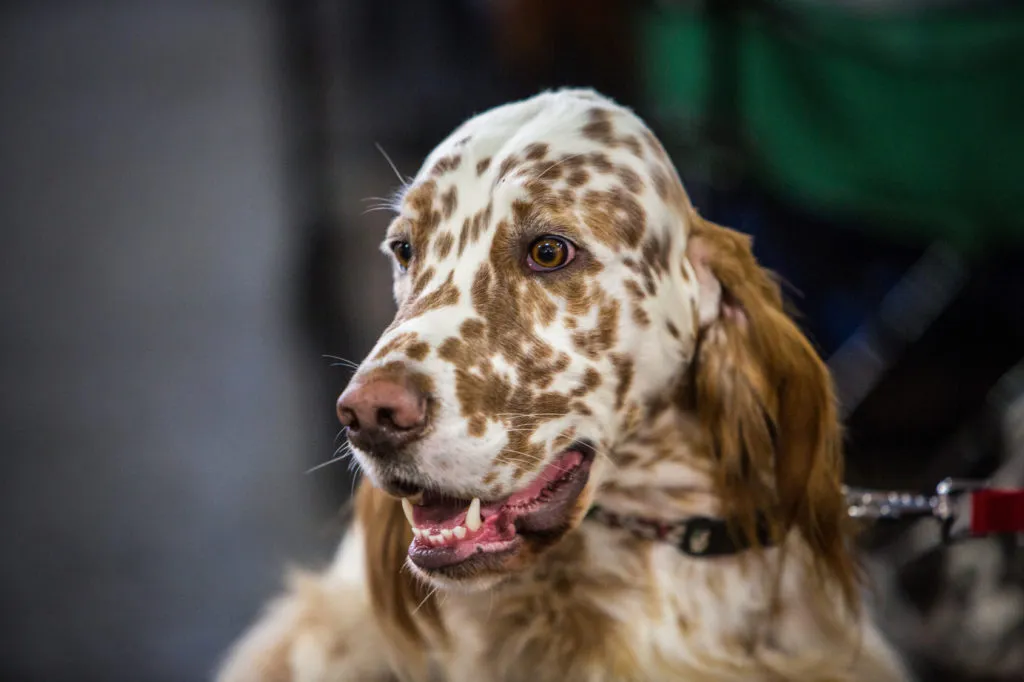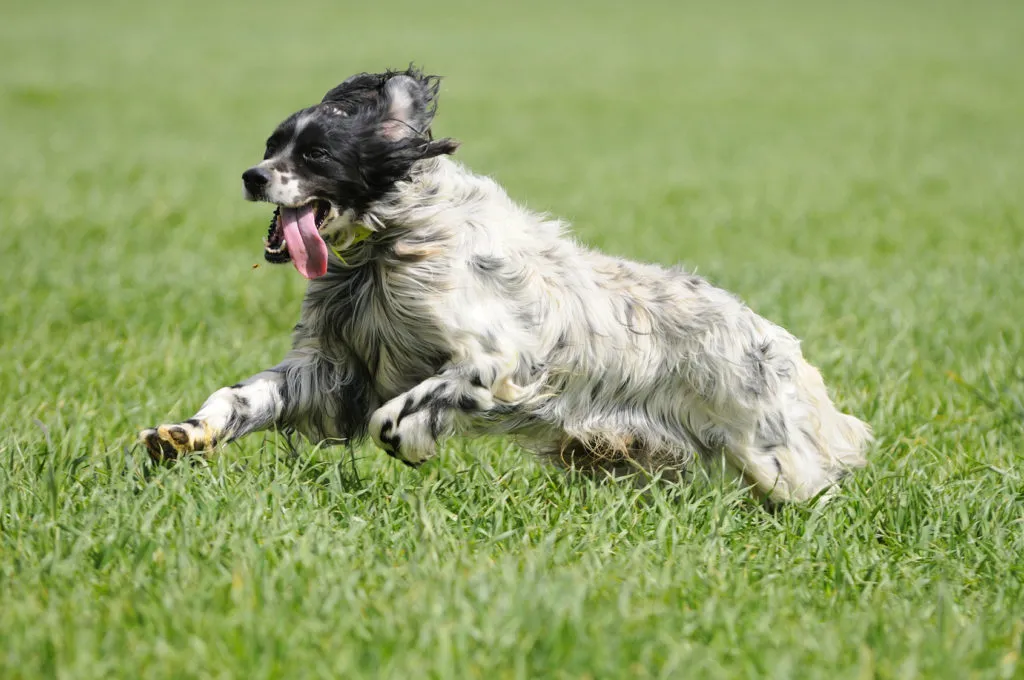Medium Size Poodle
The athletic English Setter is beautiful, smart – and a passionate hunter. If you're considering sharing your life with a member of this breed, you should have plenty of time for joint adventures in nature, as well as a solid knowledge base and experience with dogs.

© zoyas2222 / stock.adobe.com
The English Setter is an elegant, gentle hunting dog for experienced owners.
The English Setter is a very athletic and active dog, and it shows: it looks dynamic and elegant. When frolicking in the forest and fields, its floppy ears wave around – a Setter in its element radiates pure delight. While male dogs stand between 65 and 68cm tall, females can reach withers heights of 61-65cm.
Dogs from working lines are often a bit smaller. English Setters weigh around 25 to 30 kilograms. The long, silky, slightly wavy fur can be white with black, orange, lemon or brown spots according to breed standards. There are also spotted, patched or tricolour English Setters. However, the base colour is always white.
The ancestors of the English Setter include long-haired “bird dogs” used in medieval times for hunting birds. Pointers are also among the ancestors of this breed, which was significantly shaped in the 19th century by the breeding activities of Sir Edward Laverack. Laverack chose the most beautiful and stable-tempered dogs for his Setter breeding for decades and gained significant recognition.
In 1860, he presented the first puppies under the name English Setter. According to tradition, the founding dogs of the English Setter were the male dog Ponto and the female dog Old Moll.
The English Setter is a classic pointing dog that searches for its prey at high speed. When the dog, with its excellent sense of smell, has found its target, it signals this by taking a pointing position and sits still before the game – hence the origin of the name “Setter”. The hunter then gives the command to hunt, and the dog flushes the bird so that the hunter can shoot it.
Besides the English Setter, the Gordon Setter, the Irish Red Setter, and the Irish Red and White Setter are also part of the Setter family. Due to its beauty and gentle nature, the English Setter has become increasingly popular as a family dog. This development should be viewed with caution, as the traits of hunting drive and significant need for exercise have been promoted within the breed for centuries and may not always be compatible with living as a family pet.
Today, the English Setter is especially popular in the USA, as well as in France and Scandinavia, and is sometimes more common in these areas than in its homeland of Great Britain.
The English Setter is one of the friendliest hunting dogs: it is kind, good-natured, and highly sociable with both humans and animals. Therefore, it can be a suitable family dog, provided it can express its sporty ambitions. The child-friendly companion is gentle and patient. Many Setters are also real playful friends, loving to frolic around with their flopping ears.
Generally, the English Setter enjoys a lively household – it likes visitors, the company of other dogs, and can also get along well with cats if it learns to see them as part of its pack. Outside the home, however, the English Setter often transforms from a sociable cuddle bug to a passionate hunter, missing nothing – this can extend to the neighbour’s cat as well. Always keep your dog’s strong hunting instinct in mind when out and about.
 © Liutauras / stock.adobe.com
© Liutauras / stock.adobe.com
English Setters are intelligent and enjoy learning – excellent conditions for successfully training this dog. Despite its gentleness, the English Setter can sometimes be stubborn. To prevent it from becoming headstrong, this hunting dog needs clear structures and rules that offer guidance, making it willing to follow.
Consistency across all family members is crucial when training this dog, as exceptions can lead to new rules from the dog’s perspective. Remember: only a well-exercised English Setter is easy to train – without sufficient opportunities for movement and hunting, it will seek them out on its own. Training requires a high level of consistency combined with sensitivity, as the English Setter can be a stubborn little one. Experience with dogs is recommended. Check with local dog schools in your area to see if they offer specific programs for hunting dogs.
English Setters are considered very robust dogs, typically reaching an age of 11 to 13 years. Even 15-year-old dogs are not uncommon. When purchasing an English Setter from a reputable breeder, look for appropriate health screenings of the parent dogs to minimize the risk of certain conditions like deafness and hip dysplasia, which affect English Setters more often than other breeds. These friendly hunting dogs also have a slightly increased risk of gluten intolerance and skin cancer.
Keep an eye on your pet’s slim figure – especially Setters that lack movement or are neutered tend to become overweight, negatively impacting their joints. This dog’s long, silky fur requires regular care. Brush your four-legged beauty daily to avoid tangles and remove debris such as small twigs or dirt it may collect during its outdoor adventures. Only bathe your dog in an emergency and use a mild dog shampoo – usually, combing out dried dirt from the fur is sufficient. Regularly check the floppy ears and clean them with a special ear cleaner if necessary.
A significant daily contribution to your pet’s health is a high-quality dog food. Whether you opt for wet or dry food, choose pet food with a high meat content, where meat is listed first in the ingredients. Only then will your English Setter receive a balanced share of high-quality proteins.
Regarding the amount, manufacturer feeding recommendations are only guidelines, strongly influenced by your pet’s constitution and daily energy consumption. Regularly check the adult dog’s weight to prevent weight gain or loss. Active English Setters do not typically become overweight.
Feed puppies three to four times daily, while two meals per day are sufficient for an adult dog. English Setters can be sensitive to changes in their diet, so make these transitions very cautiously. Gradually mix in more of the new food with the known food daily. Always provide water to your English Setter. Suitable treats include dried chew items or high-quality reward snacks rich in meat and free from sugar. Dental care snacks can also be a good way to reward your dog healthily.
This dog is a true athlete and needs lots of daily exercise outdoors. Adult English Setters are excellent companions for jogging, cycling, or horseback riding. Ideally, the Setter should be used for hunting or, at the very least, receive similar training. Try different dog sports with your Setter: how about mantrailing? Many Setters also enjoy games of fetch. Despite all the activities, remember the importance of rest periods to prevent your Setter from becoming over-excited – shared cuddle moments and relaxation times are just as important as physical exertion. Otherwise, your pet may become perpetually stressed over time.
 © José 16 / stock.adobe.com
© José 16 / stock.adobe.com
Many dog lovers fall for the gentle nature and beautiful looks of this breed without sufficiently considering its needs. This is unfortunate for this friendly, nature-loving companion. Consider getting an English Setter only if you are a hunter or highly active. The dog’s need for exercise and delight in nature should not be underestimated.
Its fur also requires significant care, making this breed suitable only for committed dog owners with plenty of time to spend with their pets. It’s not recommended for first-time dog owners. An English Setter should not be kept in a small or city apartment; it should ideally live in a house with an adjoining garden – secure it with a fence to allow your fresh-air fan to roam freely.
If you’re planning to bring home an English Setter puppy, remember that you’re taking on a long-term responsibility for a dog’s life. Consider all the commitments involved before bringing your puppy home. An English Setter not only comes with purchase costs, typically high from reputable breeders, but you will also incur ongoing expenses for high-quality dog food, vet visits, dog tax, and insurance over its lifetime.
Think about who will care for the dog during illnesses or holidays. Ideally, a familiar family member should provide this care. The friendly English Setter can also be a fantastic travel companion, especially if planning a hiking trip. Many hotels nowadays welcome four-legged guests warmly.
When searching for a puppy, always go to a breeder who provides papers, i.e., a pedigree certificate. Never buy from private individuals or traders offering “English Setters” without papers – for your sake and the sake of animal welfare and the breed. Only reputable breeders, who follow association guidelines, can offer you a certified “authentic” English Setter. The papers should be issued by a dog breeding association.
Speak with breeders about their health precautions and get written documentation of relevant results from the ancestors. Fortunately, the paperwork for the English Setter also includes assessments of the parents’ hunting capabilities. Dog enthusiasts looking to save money often face added costs later, as puppies without papers usually lack thorough socialisation and have ancestors not temperamentally or health-wise suited for breeding.
If you’re looking for an adult English Setter, contact Setter or hunting dog clubs, which often have Setters or Setter-crosses available for rehoming. Previous owners may have underestimated the exercise needs of these sporty dogs or been charmed by their beauty and gentleness without providing a suitable Setter lifestyle. Such second-hand dogs can be challenging but also very rewarding new companions. Learn about the dog’s history and meet it during a walk to see if you’re a good match for each other.
We wish you many happy adventures with your English Setter!
Fans of the Bearded Collie agree that those who aren't familiar with this dog breed simply have to get acquainted with it. And those who have experienced how a Bearded Collie bolts across meadows with its flowing fur, how it rolls around full of energy and joy and how it attentively and observantly takes into account its owners wishes become simply addicted to this original dog breed and its unique charm.
The Goldendoodle isn't a breed, but a pairing between Golden Retrievers and Medium or Standard Poodles. Marketed as a low-maintenance dog for allergy sufferers, this hybrid is enjoying increasing popularity amongst dog lovers, similar to the Labradoodle.